Many assume that a Chevrolet Camaro and a Pontiac Firebird are essentially the same car. At their inception in 1967, they were very similar; the difference primarily being the engines and the notable Pontiac proboscis. The most significant difference in motive power belonged to Pontiac with its Overhead Cam (OHC) inline six-cylinder engine option and that’s exactly what we are going to review today. This beautiful 1967 Pontiac Firebird Sprint is located in Ontario, New York and is available here on eBay for a current bid of $8,699.
The Firebird was to the Camaro what the Mercury Cougar was to the Ford Mustang, a higher-brow version. While the Cougar was physically larger (longer wheelbase) than the Mustang, the architectural similarities were there. In the case of the Firebird, it shared dimension, suspension, sub-frame and the basic birdcage with the Camaro. The differences were the previously mentioned, identifiable Pontiac nose, some body panels, the interior, differential and, typical within the GM hierarchy at the time, the engine.
Generally, is this era, one thinks of a six-cylinder engine as appropriate for the Librarian Special, not the thing of American power. In the case of the Camaro, that’s true. Its standard power was the “Stovebolt” six-cylinder engine, displacing 230 CI and good for 140 HP. Pontiac took that basic design and modified it for OHC architecture. This was in keeping with Pontiac’s General Manager and father of the GTO, John DeLorean’s view that inspiration came from places well beyond GM’s buttoned-down, staid approach to automobile design. The thought here was European efficiency from smaller engine with greater power due to higher RPM capability. The OHC Pontiac six was manufactured between 1966 and 1969 in two different sizes, 230 & 250 CI. This Sprint has the more desirable version of 230 CI motor, fed by a Rochester four-barrel carburetor and good for 215 HP. The seller claims that this Pontiac “runs and drives great”. Notable, is that the seller indicates this Firebird connects to its rear wheels via a Powerglide automatic transmission and then corrects himself to state that it is a Super Turbine 300 – it’s a good catch on his part. While both transmissions are two-speed automatics and share architectural concepts, they are different gearboxes with no interchangeable parts. The Powerglide was a Chevrolet unit (1950-1973) while the Super Turbine 300 was a B-O-P component (1964-1969).
The red interior in this Sprint is late ‘60’s GM all the way and it appears to be perfect – it contrasts beautifully with the white exterior. I can’t say enough about how nice it is.
The underside of this Sprint looks like it did the day it rolled off of the Lordstown assembly line, it’s perfect – no sign of rot. These cars, like so many of this generation, were subject to rust on demand, especially when domiciled in a salt state like New York. No idea if this is a life-long northeast car but it presents very, very well.
The same goes for the body panels. As the seller states, rear wheel openings are the domicile of rust on this vintage Firebird and it appears to be completely corrosion free. The 52-year-old Cameo Ivory lacquer finish has withstood the test of time and is still bright and clean.
So, why go for an everyday Camaro when you can have a more unique variation like this Firebird, further rarefied by the OHC six-cylinder engine? Especially a 53,000-mile example that is as original as this example? The standard Firebird’s V8 was a 326 CI engine good for 250 HP, this six isn’t that far behind at 215. The standard ’67 Camaro V8 was only 210 HP being further bested by this unique and rare OHC six-cylinder engine – a sign of GM’s ‘60’s can-do engineering spirit. This one gets my vote!
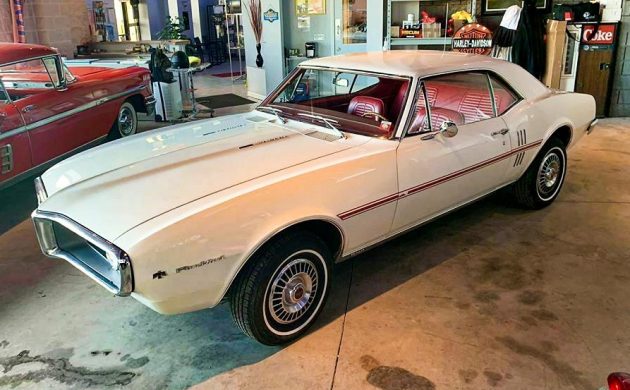
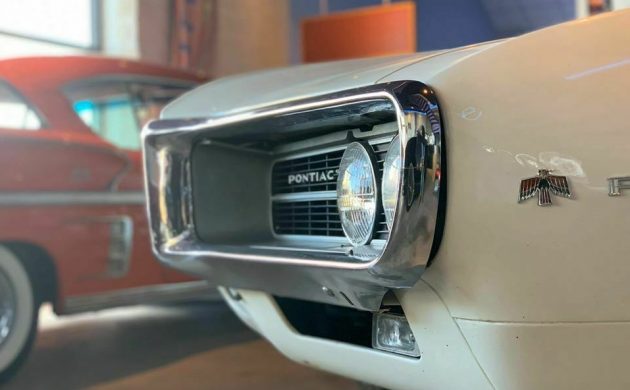
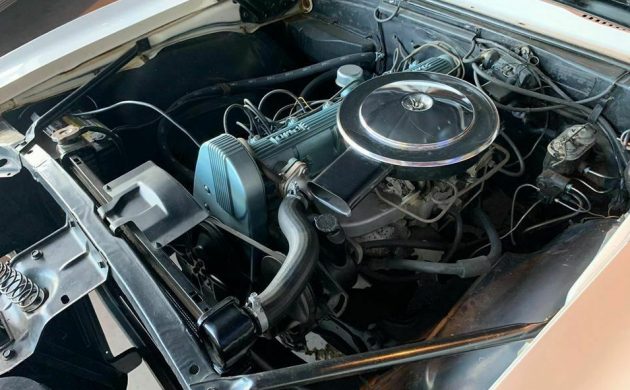
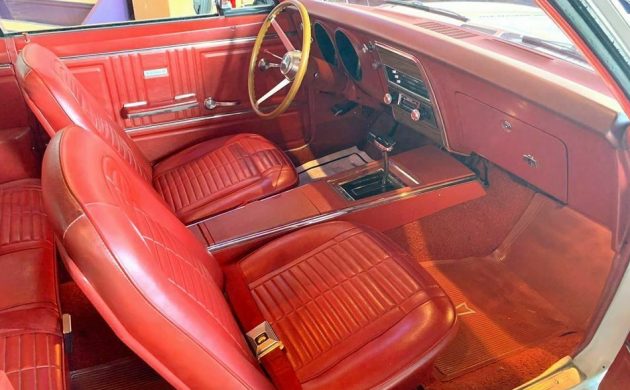
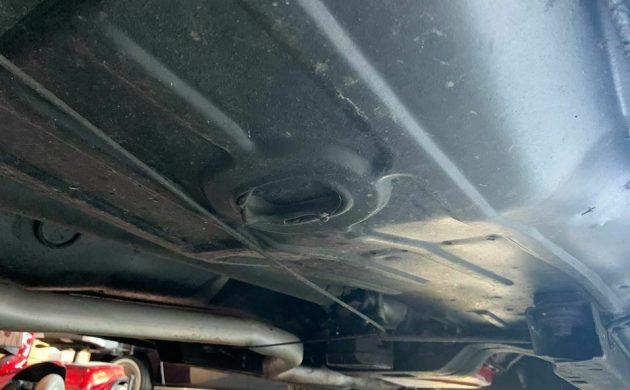
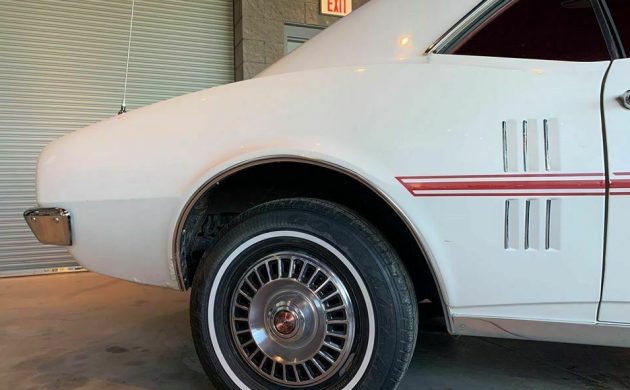
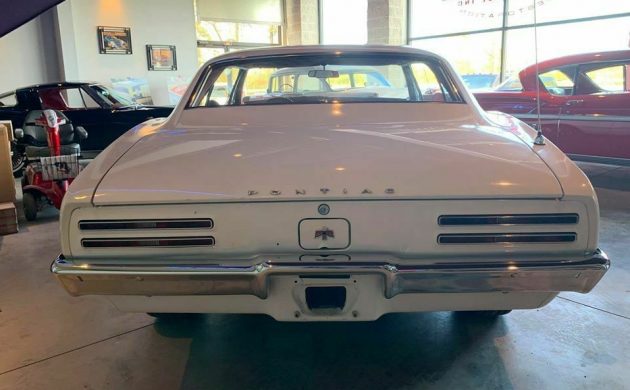


wow, this thing is clean!
underside looks good enough to eat from.
love these under appreciated OHC gems.
always wanted one with 4-speed in green and hood tach.
bet they are one of the best handlers from the era.
My mother bought one new in ’67. OHC 6, 4 bbl, 3 speed. Red on red with white rag top. A Camero bird dogged me late one night on a back country road. He attempted a pass about 90 but he couldn’t. We met up afterwards and he couldn’t believe I had a 6 as he had an 8. You’re right. That light frt end paid off.
Road and Track said it redlined about 110 mph. Decided to make a speed run one night. At 110 -115 the engine ceased to sound like an ICE and began to sound like a sewing machine.
It was my mom’s car but I threw caution to the wind and kept my foot down. The car continued to accelerate. I hit 120 on the speedo which was at 4 o’clock on the dial. The car was still willing. I got off the throttle when the needle pointed straight down at the 6 o’ clock position. That was about 140 if it was accurate.
Believe it or not.
I. WANT. IT.
Badly, sinfully even……
What a great driver! Here is my “Buddy had one” story- Buffalo NY 1969. Buddy had a green convertible with the inline six and a three-speed. Keystone mags of course. We are spending the day at Crystal Beach Ontario and Buddy says “Take the car and get some folks up here for a party”. Aye-Aye Captain!! We used up his entire book of Peace Bridge commuter passes shuttling ready, willing , and able party-goers over the bridge. Life was much simpler (And probably) more fun back them.
I have such the silly pet peeve about the ST300 / powerglide thing, 10,000 cool points for his correction lol.
This is such a great car, I want it.
My 67 SS327 Nova had a Powerglide. I swapped in a fully-built TH200 OD w/locking converter. WHAT A DIFFERNCE! I ican do 70 all day long, with 3:73’s and tach at about 2100. Nice thing is that it’s reversible in an afternoon!
Read a recent article on restoring an OHC 6. They said the parts were very rare, with few survivors. Nice looking car.
I restored one in 1987, before the internet, and yes parts were rare back then. Mine was in a 67 tempest. The hard part was getting a cam. People would let the engines sit, and the oil would gravity drain and eventually wear the cam. The lobes on mine were almost round.
I found a 68 in a junkyard in upstate PA that had one. The guy said I could take anything off the top of the engine for 50 bucks. I took the carb, the air cleaner, the valve cover with cam, and the head. I figured why not?
My brother worked at a machine shop and redid the head. Pistons and rings were good, so we left the bottom end alone. Besides the cam, one of the hardest parts to source was a decent Rochester one barrel.
I wish I would have taken more photos of the restoration. It was fun, but back then people didn’t document everything like today. Also, today, I can order a cam ground to my liking in 30 minutes. Good times!
Hi Jim, were these the ones you could get with an optional 4 bbl carb?
Oh my word! Ah, a 1967 Firebird Sprint. The very car that got my family into Firebirds and my earliest memory of my dad’s sh*t eating grin as he traded our Corvair Lakewood wagon on a bronze beauty with redline tires and simulated mag wheel covers. Cheshire cat as he pulled into the driveway and individually threw all of us kids in the front seat for a spin around the block. Traded it for the more executive 326 V8/auto Firebird with a white vinyl interior which I remember sticking to in my bathing trunks as a kid. The only negative thing on this listing is why emphasize the front beak when it looks like the bumper may be pulled away on the driver’s side? Also, if I was ordering this car in 67, white would not be my first choice of exterior finish. Finally, this thing screams for Rally I PMD wheels and a set of red sidewalls! Nice. Hope it stays around the $10k mark but I doubt it will!
The sticky vinyl was called “Morrokide” . And yes, I do wish I had the brain space back that is holding Morrokide memories for something a little bit more important.
Around $10k? No way!
Up to over 15K
Great car. I’d change nothing on it except a switch to Pontiac Rally Wheels (while keeping the originals, of course)
It’s up to $15,100.00 now…and it looks like the reserve is off…two people slugging it out on the bidding…love this car, but too rich for my blood…
Very nice! That Sprint six is different enough to certainly garner attention at shows.
I hope the winning bidder understands the significance of an original, unmodified Firebird Sprint. With such a solid body, this could easily fall victim to a V8 conversion.
No way does this car “easily“ fall victim to a V8 swap. There’s no reason to spend that kind of money on a Firebird unless you’re keeping it stock. Plenty of others out there that you can LS swap without ruining a rare bird.
Great car with a cool engine…..I also hope the keep it original!
I dont think the Camaro used the “stovebolt” that was a 235 inch…the 230 and 250 both based on the 2.5 liter 4 cylinder design (as was the 194 on the chevy II)
gets confusing. chrysler had a 2.5 and 2.6 totally different engines!!!
the stovebolt came out in ??53??? .
I believe the origins of the “Stovebolt” name go back to at least the mid-1930s. Same basic design used up through the 1970s–pretty good run General Motors! Of course the blocks, bores, carburation, manifolds, etc were modified over the years to fit the needs of the buying public. I think I’ve even heard an old timer call the factory motor in his 32 Chevy roadster a Stovebolt.
“Generally, is this era, one thinks of a six-cylinder engine as appropriate for the Librarian Special, not the thing of American power.”
Hey! I’m a librarian that daily drives a 2015 Chrysler 300s and fun drives a 1971 Dodge Charger 500 with a bored out 400!! Sure the 300 has a V6 (300 horses!) and the Charger has 276 gears. Librarians are much more fun than the sterotypes make us out to be…;)
So what happened to this engine. Pontiac only kept it around a couple years and it seemed to have promise then it disappeared.
As a side note I was reading a 1967 car and driver and they stuck this engine in a xke, interesting reading.
Made no sense, a standard V8 had more power, cheaper to make, and in those days people tended to laugh at anything that wasn’t. (Got a lot of judgement rendered over my slant sixes) This one was a 4bbl. What was the mileage? I think a 2bbl made more sense as far as gas use and costs. A 2bbl makes a six from that era run better, and sometimes better MPG too. Could you get them with a 2bbl? I never understood the 4bbl on these, if you wanted power, why not just go with the cubic inches?
The ohc strait 6 either came with a 1 barrel or a very small quadrajet. & maybe pontiac offered this motor to have more performance than chevy’s 250, while still being just as light – for better handling, & traction in the snow – my theory.
Any pontiac v8 back then – even a 326 was extremely heavy, & a small block chevy v8 was also heavier than the strait 6. & both would not be good in the snow or rain, IMO.
I had asked that same question awhile back. I learned as Grandpa said that it was expensive to build and gas was 29.9 so fuel efficiency wasn’t in demand yet. I remember when Pontiac came out with these and thought it seemed modern and progressive to build OHC engines. If decent fuel injection was available then I think these would have been great power plants.
My first car in 1975 was a 1968 Camaro convertible RS . Was under the impression that it was an in line 6 250 ci. Loved it but when insurance became compulsory I couldn’t afford it at the ripe age of18 and still in school.
Had a 1967 firebird with this engine I bought back in about 1972. Had alot of fun in that car, but all my buddies made fun of it because it was a 6 cylinder.
Kept that car till the early 90’s, can’t remember ever having any major problems with it.
Very nice but there is some rust on the right quarter that will need attention, And probably more not seen in the pictures.
😲 I HAV A GOOD COMPLETE FRONT
CLIP no rust 4 A 69 350 PONTIAC FIREBIRD
BEEN SITTING on roof 4 40+ years😎
The OHC Pontiac 4barrel model used a quadrajet. They would get excellent mileage if you kept your foot out of it.
And what fun would that be?
I’ve always wanted to drive one of these OHC Sprints (4 sp) and see what it’s like.
One fact most do not know about the firebird and the tempest is that if you got a 3 speed in some of the early years it had FoMoCo on the side of the transmission. Yes GM bought the fully syncro. 3 speeds from Ford because GM did not have a good three speed and pretty much never did.
I might be seeing things but I see rust bubbles behind the rear wheel on the RH side in one pic.
A friend just finished restoring a 69 HO RA firebird numbers matching cost $135,000 to restore and on a good day would bring $80,000 at auction. BTW he got the car for two months past due rent so nothing in the car itself. Today’s cost for parts and materials have way past the value of the cars. You cannot do a perfect restoration and make any profit.
In my opinion the firebird was a much better looking car than the Carmaro!!! I have never seen this motor so I’m wondering if this is a unicorn firebird!! I sure someone knows!! The red interior looks flawless!! Never have a been a fan of white cars but it matches good with the red interior!!
In 1972. I was 16 and got my license. My dad said if I paid for a car I could get one. I found a 66 Tempest 2 door with the OHC and a 4 speed. Being from a Pontiac family, I figured my very strict and utilitarian dad would approve. My friends had Road Runners and SS Chevelles. The cat was at The local Dodge dealer and being fron a small town, everybody knew everybody. My dad ran the local 5 and 10 and a hardware supply store. I go in and offer $750 cash I earned from my construction job. The Dodge dealer, still alive saw him at Hershey 2019, said no. The asking price was I think $995. The car was blue and in pretty good shape. I ride my bike to see pop. He says I learned you made an offer on a car. You are not buying it. I argued it was my money. He said Bruce called and told him to not let me buy it. It was a POS. Anyway, I got a 66 Chevelle conv for $400. Meanwhile, this car is super nice. I eoukd kill to own it. Like others here, In hope whoever gets it does not out a stupid LS engine in it. Long live Pontiac.
Nice…..like !
I don’t have the room and negotiations for more space are going slowly.
Otherwise I’d jump on it.
Lots of interesting comments here. However, I have a question…Was this car really built at the Lordstown, Ohio plant as the description says? I know that there was a GM plant there for many years, but, to my knowlege, all F-body cars were built at either the Norwood, Ohio (near Cincinnati), or, Van Nuys, California (Los Angeles) plants. The Lordstown plant, which was near Youngstown, closed in the early 2000s. The last vehicles built there were Chevy Trail Blazers and other SUVs on that platform.
Yes first generation firebirds were built at lordstown….Norwood was a Chevrolet plant only at that time……Firebirds where later built at Norwood along with Camaros
Lordstown plant was making the Chevy Cruze as recently as 2018. GM just shuttered it this year. You are correct that the majority of Firebirds were made at Norwood or Van Nuys. Perhaps the OHC engines were built at Lordstown? The General has many plants that just manufacturer powerplants for other divisions and factories.
Lordstown did build first gen firebirds….the “L” in the vin is for lordstown on first generation firebirds
When pontiac realized their ohc 6 did not sell well in ’67 & ’68 firebirds, in ’69 they simply installed the chevy ohv 6 – though i wonder if they could have installed their ohc 6’s much better intake & exhaust manifolds onto the chevy ohv 6! Maybe they were too expensive to make?
@JoeNYWF64 My dad owned a 1969 with a factory OHC 6, pale green, base interior, 3 speed on the floor. So I’m not sure how accurate your comment is, or when corporate-wide they began dropping more conventional sixes into Firebirds. It was a rare bird indeed and we loved the car after having a miserable experience with a brand new 1973 Camaro. Yes, my belligerent Dad went back a number of production years to get the used Firebird he was jones-ing for.
Oops i meant starting in 1970.
https://en.wikipedia.org/wiki/Pontiac_Firebird#Engines_2
vs
http://en.wikipedia.org/wiki/Pontiac_Firebird#Engines
What problems did you have with the ’73 & what engine was in it?
I don’t think my Dad’s had a 4bbl, probably the lower horsepower OHC but it was called out on the hood just like in 67 and 68. I’m pretty certain the “sprint” designation was gone by then though. His looked just like this, except without the vinyl top. Even the thin white sidewalls are correct on this much more recent photo. The ill-fated 73 Camaro had the ubiquitous 350 motor, crankshaft ran through the main bearing among other issues. We thought at the time that car was possessed. It was in the shop under warranty more than driven any great distance regularly. I think we were able to take one long road trip in it where I had to sit on a slice of dark green vinyl covering the transmission hump for a back seat. No center seat belt back there either.
I have a 68 firebird 4.1 liter, it has deluxe interior a chrome piece around the dash. Multi leaf rear springs 4 drum breaks and power/ air boosted brake system. Looking at the sprints and none have air assistance breaks.
The above featured Firebird is strikingly similar to the car my Dad bought for the family but primarily for my Mom in 1972 in Vernon, B.C., Canada (at my insistence – following a R knee ACL injury, just prior to my 16th birthday, I had played the sympathy card to the hilt!). My Mom learned to drive with this car but was overly cautious and extremely traffic-shy, thus, upon obtaining my D/L, this car got commandeered by yours truly. Lucky me eh? I had few so-well-equipped peers in high school in Kelowna, B.C.
Our car had a hood tach and no red accent stripe down the sides but was otherwise identical … except for being a Canadian market car.
I recall that it had a four-barrel Quadrajet carb and split exhaust manifolds but cannot say for sure it was a 230 c.i. engined car, however, I believe that was the sole Sprint OHC 6 option (no A/C or A.I.R. on our car either). I seem to recall the ‘OVERHEAD CAM’ lettering on either side of the hood bulge but do not recall what the prefix emblem / lettering said (nor do I recall any rocker panel ‘OHC 6 SPRINT’ emblems on the polished SS rocker panel pieces), however, it’s been 50+ years now … memory fails.
I also recall getting the car up to about 120 MPH one time and scared myself pretty good, as the front end was lifting as if the car was trying to be an airplane.
Sadly, the OHC 6 engine suffered a catastrophic failure in 1974/5? (cam drive belt?) and got pulled in favour of a Chevrolet 283 c.i. V8.
I have no idea what was done with the OHC 6 engine by the garage that performed the engine swap, however, it’s pretty safe to say it’s way long gone and permanently separated from the car itself, should the latter even survive.